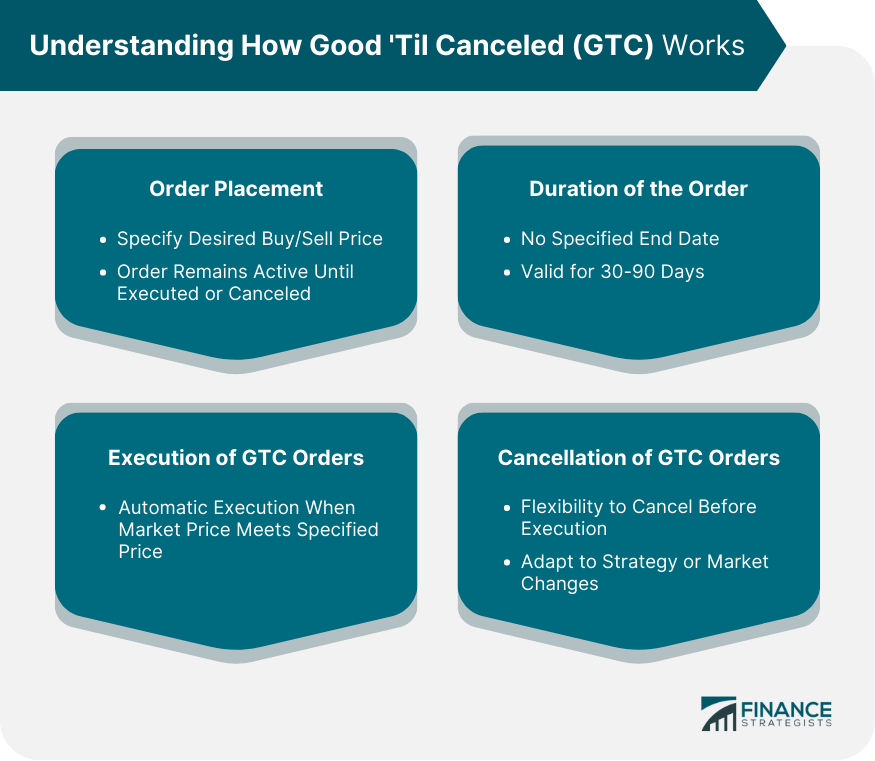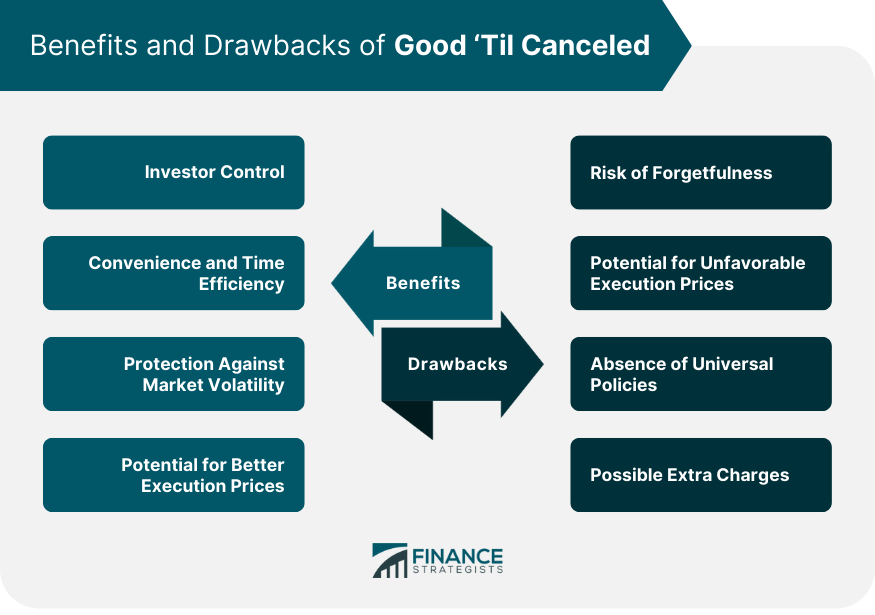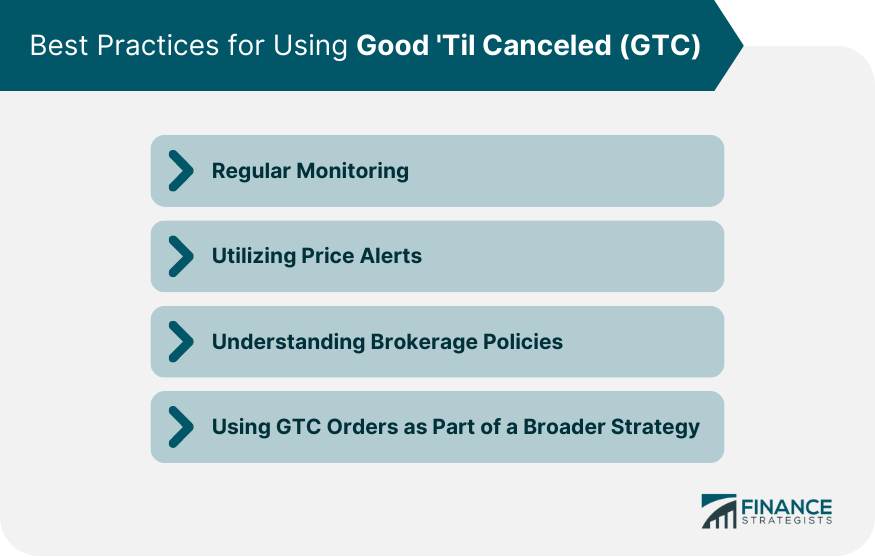In the world of investing and stock trading, a Good 'Til Canceled is a buy or sell order that remains active until the investor decides to cancel it or the order is filled. Unlike day orders, which expire at the end of the trading day if they haven't been filled, GTC orders could potentially stay active for an indefinite period, depending on the brokerage’s policies. The main purpose of a GTC order is to allow an investor to set a specific price at which they wish to buy or sell a security and then wait for the market conditions to meet their set parameters without having to monitor the market constantly. The importance of this type of order lies in its ability to provide the investor with greater control over the execution of their trades and to automate the trading process, thereby providing convenience and potentially protecting against market volatility. When an investor places a GTC order, they specify the price at which they want to buy or sell a particular security. This order will then remain active in the market until the price condition is met and the order is executed, or until the investor cancels the order. GTC orders do not have a specified end date and will continue to be valid until the trade is executed or the order is canceled by the investor. However, it's worth noting that some brokerages may set a limit on how long a GTC order can remain open, typically around 30 to 90 days. A GTC order is executed when the market price of the security reaches the price specified in the order. When this occurs, the order is automatically filled, and the investor buys or sells the security at the price they previously specified. Investors can cancel a GTC order at any time before the order is executed. This provides the investor with flexibility if their investment strategy or market conditions change. However, investors must remember to cancel their GTC orders if they no longer want them to be filled. When placing a GTC order, an investor sets the exact price at which they want to buy or sell a stock. This means that they can strategize their entry or exit points in the market, potentially securing a good deal even in their absence. This control mechanism is particularly beneficial when dealing with stocks that have high price volatility or when an investor predicts that a stock will reach a specific price point in the future. Once a GTC order is placed, it remains active until the desired conditions are met. This provides the investor with the freedom to focus on other things while still ensuring their trading activities are underway. They don't need to repetitively place the same order each day, providing significant time efficiency. Investors can be safe in the knowledge that their buy or sell conditions will execute when their set price is met, protecting them against potential price spikes or drops. They are particularly useful in volatile markets, where prices can fluctuate significantly within a trading day. By setting a GTC order, investors can essentially lock in a price, ensuring that they can take advantage of favorable market conditions, even if these conditions are fleeting. As an investor, you get to define the exact price at which you're willing to trade a security. This way, the order will only execute when the market price meets your predetermined price, which could be much more favorable than the current market price. This can lead to profitable trades, especially in volatile markets or with thinly traded securities where prices can fluctify considerably. Given the indefinite duration of these orders, it's easy for investors to place an order and then forget about it, especially if they are managing a large portfolio or are not trading regularly. If the market conditions significantly change or if the investor's strategy shifts over time, an unforgotten GTC order may execute at an unfavorable time. For example, if a GTC sell order was placed on a stock, and then the stock's value started to rapidly increase, the order could inadvertently limit the investor's profit if not cancelled in time. If the market conditions change rapidly or unexpectedly, a GTC order might execute at a price point that's no longer ideal. This is especially true for volatile markets, where prices can drop quickly. If an investor has set a GTC order to buy a security at a specific price and the price drops far below that limit, the order will execute at the higher limit price, potentially leading to a significant loss. Each brokerage has its own rules concerning how long GTC orders can stay open, typically ranging from 30 to 90 days. Some brokerages might also have specific regulations and fees related to GTC orders. These varying policies can lead to confusion and unexpected outcomes for investors, particularly those who use multiple brokerages for their trading activities. While these fees may seem nominal on a single order, they can add up when multiple GTC orders are placed over time. This can cut into an investor's profits, especially if the GTC orders are for smaller amounts. Therefore, investors must thoroughly understand the fee structure of their chosen brokerage before placing a GTC order. Placing a GTC order is generally straightforward on most online trading platforms. Once you've chosen the security you wish to buy or sell, you'll select 'GTC' from the duration or time in force options. After entering your desired price, you can review and submit your order. While placing a GTC order is typically straightforward, complications can arise. For instance, if your broker has set limits on the number of open GTC orders, you might have to cancel an existing order before placing a new one. Or, if you're placing a GTC order on a security with low trading volumes, the order may take longer or not fill at all. If you encounter difficulties, your broker's customer service should be able to assist. Despite the set-and-forget nature of GTC orders, it is not wise to completely ignore them after placement. Regular monitoring is a key best practice when using GTC orders. This is because the financial market can change rapidly, and an order that made sense yesterday might not be in your best interest today. By frequently reviewing your GTC orders, you ensure that they align with your current investment strategy and market conditions. This can also prevent the unintentional execution of orders that are no longer desirable. These alerts can notify you when the market price of a particular security is nearing the price specified in your GTC order. By receiving an alert, you have the opportunity to reassess your GTC order in light of the current market conditions. It provides a chance to adjust or cancel the order, if necessary, before it executes. This strategy can be especially helpful in volatile markets where price movements can be swift and significant. As there are no universal rules regarding GTC orders, it's crucial to understand your brokerage's specific policies. These can include how long a GTC order can remain active, what happens when a GTC order reaches its expiration date, and whether there are additional fees associated with placing or maintaining a GTC order. By fully understanding these policies, you can use GTC orders more effectively and avoid unexpected surprises. GTC orders can be a powerful tool in your trading arsenal, but they shouldn't be the only strategy you use. Instead, they should be part of a broader investment strategy that includes various types of orders and takes into account a range of market conditions and investment goals. It's also essential to consider your risk tolerance and investment timeline when placing GTC orders. By using GTC orders judiciously and in conjunction with other strategies, you can optimize your trading activities and potential returns. Good 'Til Canceled orders provide investors with control and convenience by allowing them to set specific prices for buying or selling securities. The benefits of GTC orders include investor control, convenience, protection against market volatility, and potential for better execution prices. However, drawbacks such as the risk of forgetfulness, potential for unfavorable execution prices, varying brokerage policies, and possible extra charges should be considered. To maximize the use of GTC orders, it is important to follow best practices. Regular monitoring ensures alignment with market conditions and investment strategies. Price alerts can provide timely information for reassessment. Understanding brokerage policies helps avoid surprises. It is also crucial to incorporate GTC orders within a broader investment strategy, considering risk tolerance and timelines. By implementing these best practices and utilizing GTC orders as part of a comprehensive trading approach, investors can enhance their trading activities and aim for optimized returns.What Is Good 'Til Canceled (GTC)?
Understanding How Good 'Til Canceled Works
Order Placement
Duration of the Order
Execution of GTC Orders
Cancellation of GTC Orders

Benefits of Good 'Til Canceled
Investor Control
Convenience and Time Efficiency
Protection Against Market Volatility
Potential for Better Execution Prices
Drawbacks of Good 'Til Canceled
Risk of Forgetfulness
Potential for Unfavorable Execution Prices
Absence of Universal Policies
Possible Extra Charges

Steps to Place a GTC Order
Instructions for Online Trading Platforms
Potential Complications and Troubleshooting
Best Practices for Using Good 'Til Canceled
Regular Monitoring
Utilizing Price Alerts
Understanding Brokerage Policies
Using GTC Orders as Part of a Broader Strategy

Conclusion
Good 'Til Canceled (GTC) FAQs
A GTC order is a type of buy or sell order placed by investors that remains active until it is executed or canceled by the investor.
GTC orders do not have a specified end date and can remain active indefinitely, depending on the brokerage's policies. However, some brokerages may set a maximum duration, typically ranging from 30 to 90 days.
Yes, investors can cancel a GTC order at any time before it is executed. This provides flexibility if market conditions change or if the investor's strategy shifts over time.
When the market price of the security reaches the price specified in the GTC order, the order is automatically filled, and the investor buys or sells the security at the predetermined price.
While GTC orders offer advantages, there are risks to consider. These include the potential for forgetfulness, where an order might execute at an unfavorable time if not canceled, and the possibility of unfavorable execution prices if market conditions change rapidly.
True Tamplin is a published author, public speaker, CEO of UpDigital, and founder of Finance Strategists.
True is a Certified Educator in Personal Finance (CEPF®), author of The Handy Financial Ratios Guide, a member of the Society for Advancing Business Editing and Writing, contributes to his financial education site, Finance Strategists, and has spoken to various financial communities such as the CFA Institute, as well as university students like his Alma mater, Biola University, where he received a bachelor of science in business and data analytics.
To learn more about True, visit his personal website or view his author profiles on Amazon, Nasdaq and Forbes.















